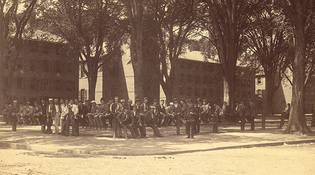 loading
loading
Old YaleDeciding to stayIn 1868, Yale considered moving out of central New Haven. Judith Ann Schiff is chief research archivist at the Yale University Library.  Manuscripts and ArchivesThe Yale Fence, seen here in 1888, ran along Chapel and College Streets from 1837 to 1888. Yale eventually walled off the Old Campus from the town with new buildings. View full imageYale marks the milestones in its history with pride: the official founding in 1701, the decision to move to New Haven in 1716, and the renaming in 1718. The events of 1868 may not be as well known, but their 150th anniversary merits attention. In that year, Yale contemplated uprooting itself and moving further north before recommitting to central New Haven. Yale’s enrollment had grown impressively in the middle of the nineteenth century, and the need for new dormitories had been acute since at least 1846. Most Yale buildings stood on the Old Campus, which was then called the College Square. The aging Old Brick Row, a series of utilitarian buildings that included Connecticut Hall, sat back from College Street. The space between the buildings and the street formed a kind of front yard. It was enclosed by a wooden fence (known for decades as the Yale Fence) and shaded by a line of stately elms. In 1868, the ground in front of Connecticut Hall was staked out for a new dormitory funded by railroad magnate Henry Farnam. At the same time, Yale revealed a plan to build several more buildings on the outer edges of the block, enclosing the Old Campus, and to demolish the Old Brick Row. In Four Years at Yale, Lyman Bagg, Class of 1869, described the reaction: “The ground had hardly been staked out and the general plan of reconstruction made public, when a cry was raised in the newspapers that the beauty of the college green—the pride of the city—would be ruined thereby; and the champions of the elms exhorted the authorities to put up their murderous axes and spare those noble trees.” Faced with these objections, and given that most adjacent properties were unavailable or unaffordable, Yale began to talk about moving to the outskirts of the city. The 1869 alumni report outlined the plan: “A hundred thousand dollars would secure a lot of fifty acres, extending from Prospect Street to Whitney Avenue, about half a mile north of the residence of the late James Hillhouse, Esq. The very great beauty of such a position, on the ridge between East and West Rocks, and commanding the finest views of both, will be recognized by all the graduates.” It was decided that while removal would be advantageous, Yale couldn’t afford it. To placate both the town and the alumni who protested removal, Yale quietly broke ground on a different site—just up College Street, near the intersection with Elm—for Farnam Hall in August 1869. It would be the first building of a “new dormitory system.” Only three elms were cut down to make room for it, and the view of campus from Chapel Street was barely affected. Eventually, further construction would almost completely enclose the block, as originally planned, producing the Old Campus we know today. In 1888, the alumni lost the “fight to save the Fence” at the corner of Chapel and College, and all the Old Brick Row buildings but Connecticut Hall were razed in time for Yale’s Bicentennial in 1901. Today, the lasting impression of the stately elms in Yale’s front yard can be found in Charles Dickens’s American Notes, on his 1842 tour: “The various departments of this Institution are erected in a kind of park or common in the middle of the town, where they are dimly visible among the shadowing trees.” And later by Henry Baldwin, Class of 1871, in his classic Yale song “’Neath the Elms”:
The comment period has expired.
|
|